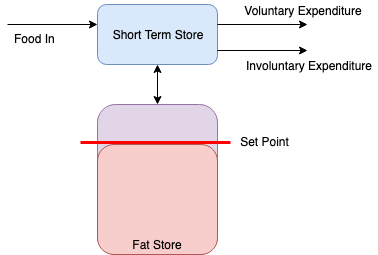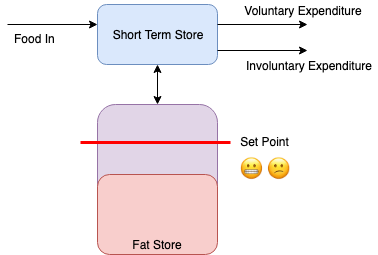Calories In Calories Out
All diets work, all diets fail. Any diet that restricts energy intake for a while will see initial positive results. Unfortunately however, in the mid- to long-term, the weight loss stalls, compliance crumbles and the weight is regained. Plus some. With a little guilt and self-loathing thrown in for good measure.
However, this is not an accident, nor a failure of will or self-control. It’s the body doing its best to keep you alive.
The ‘calories in, calories out’ model is neat, elegant and highly plausible. And wrong. If it was right then the simple advice to ‘eat a bit less, move a bit more’ would work. But it almost never does. I think I know why.
1. The One Tank Model
The ‘calories in calories out’ model is summarised below.

We take in energy as food, and expend it voluntarily (eg during exercise), or involuntarily (ie our metabolic rate). The ‘eat less, move more’ requires that
- We consciously control the ‘Food In’ over the long term
- Involuntary Expenditure remains constant
Wrong and wrong.
2. The Two Tank Model
Let’s make the model a little more complicated and perhaps more useful. The inputs and outputs are the same but instead of being a simple fuel tank, we have a short term store of energy and a long term one - ie the fat store. Energy can be exchanged between the two stores.

It is thought that the body has a ‘set point’ that is defended using appetite, motivation and available energy for voluntary activity and the flexing of our metabolic rate. The mechanisms that do this are amazing, and we’ll happily consume not far off a million calories of food a year and our weight barely budges. The notion that this degree of accuracy is achieved with conscious control is risible - our body’s are smarter than we are.
3. All diets work, all diets fail
All diets work to start with. We eat a bit less, and move a bit more. And, hoorah, for a while the weight comes off. And we look a bit better. And we feel good about ourselves.

However, eventually your body says ‘enough’. It will not sit idly by and allow you to waste away - you have a job to do to get your genes represented in the next generation! So three things happen.
- Your appetite increases
- Your have less energy to engage in voluntary activities
- Your involuntary expenditure goes down
And the fat store recovers back to the set point, and perhaps even adjusts the set point up a bit for safety’s sake given the owner is clearly not to be trusted.
4. So, how do you change the set point?
The body’s mechanisms are all working beautifully and correctly, except… Except that if you are overweight it’s defending a set point that is too high. So the important question is : how do you change the set point?
I don’t know. But if I had to speculate I’d say the underlying cause is hormonal dysregulation, and speculate again that this is caused by consuming foods at odds with our ancestral heritage.
My best guess : Eat Real Food. Meat, fish, eggs, nuts, vegetables, bit of fruit perhaps, seeds. I suspect it’s not impossible to become overweight eating real food, but I bet it’s hard.
Simple right? Unfortunately simple doesn’t mean easy - the modern environment is toxic : go to any coffee shop, supermarket or service station and consider what would be left if you removed everything that is not real food. Making one good choice is easy; making hundreds a day less so.
5. Summary
Counting calories is a waste of time. You can create a deficit in the short term but our bodies are way smarter than we are and will easily over-rule our crude endeavours. Eat the foods that we’re adapted to eat and the body’s mechanisms will be able to work just as they did before we ate processed foods that we’re ill-suited to consume.
